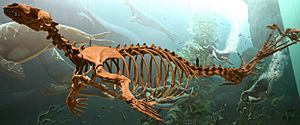Acrophoca facts for kids
Quick facts for kids Acrophoca |
|
|---|---|
 |
|
| Display at the Smithsonian National Museum of Natural History | |
| Scientific classification | |
| Genus: |
Acrophoca
|
| Species: |
longirostris
|
Acrophoca longirostris was an ancient seal that lived a long, long time ago. People sometimes call it the swan-necked seal because of its long neck. It's now extinct, meaning it doesn't live anymore. Scientists first thought it was related to the modern leopard seal, but now they believe it's an early type of monk seal.
Contents
About Acrophoca
How Scientists Group Animals
Scientists found fossils of Acrophoca longirostris in places like Peru and Chile. When they first found it in 1981, they thought it was a relative of seals like the modern leopard seal. These seals are known as lobodontine seals. They include the crabeater seal, the Weddell seal, and the Ross seal.
However, scientists now think Acrophoca is an early kind of monk seal. It is closely related to another extinct seal called Piscophoca. This shows how scientific understanding can change as new discoveries are made!
What Acrophoca Looked Like
Acrophoca was about 1.5 meters (5 feet) long. That's about the length of a small car! It wasn't as good at swimming as seals today. Its flippers were not as developed, and its neck wasn't as smooth for moving through water. This might mean it spent a lot of time close to the shore.
Its Unique Neck and Teeth
Unlike other seals without outer ears, Acrophoca had a long and flexible neck. Its body was also quite long. Its teeth were good for piercing, which suggests it ate mostly fish. But its teeth also fit together in a way that could help it filter food from the water. This is like how some animals filter tiny bits of food.
Acrophoca's back flippers were important for swimming. The way its hips were shaped also helped it swim using its hind limbs. It was not as well-suited for the open ocean as some other seals. This suggests it lived in waters close to the coast.
Where Acrophoca Lived
Scientists have found Acrophoca's fossils with other ancient animals. These include the marine sloth Thalassocnus and the tusked whale Odobenocetops. They also found fossils of animals that are still alive today. These include bottlenose dolphins, gannets, and cormorants. This helps us imagine what the ancient ocean looked like when Acrophoca was swimming!
See also
 In Spanish: Acrophoca para niños
In Spanish: Acrophoca para niños


